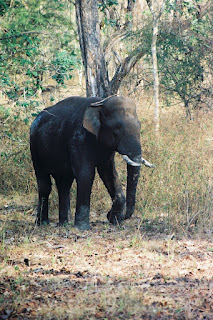After being around on Blogger since 2004, the 100th post is finally here! Made me look back at some of the old posts and also got me thinking as usual about how lazy I have been! Surely there were so many things that I could have penned my thoughts on for the last 6 years but since nothing can be done about it, I proceed to dedicate my 100th post to a creature I have come to love and admire. Just a sight of this giant among beasts pierces my soul and makes me offer a silent prayer to mother nature for I have been privileged to see this wonderful creature several times in the wild. Carefree and of course born free! Ladies and Gentleman a standing ovation for Elephas maximus aka The Asian Elephant.
Most of us in India do not need an introduction to the Elephant, for it symbolizes perhaps the most widely worshipped god in the country - the elephant headed remover of obstacles - Lord Ganesha. It would be impossible for me to imagine anyone from my generation not having been told the story of Lord Ganesha either when getting fed by their dear grand parents or when getting tucked into bed by mommy or daddy dearest, so I shall spare the reader from going through the details of how Lord Ganesh got his elephant head. I also don't consider myself an expert in Zoology to be able to fill this post with details of the elephants anatomy, behavioral traits etc. Rather, I wish to share some of the memories I have had with these creatures during my numerous visits to the forests of South India.
The Western Ghats harbors the largest wild population of wild elephants in southern India. There are eight main populations in southern India, each fragmented from the others: northern Karnataka; the crestline of Karnataka–Western Ghats; Bhadra–Malnad; Brahmagiri–Nilgiris–Eastern Ghats; Nilambur–Silent Valley–Coimbatore; Anamalais–Parambikulam; Periyar–Srivilliputhur; and Agasthyamalais (Source: http://www.iucnredlist.org/apps/redlist/details/7140/0)
My first memories of seeing wild elephants are probably from my college days when I happened to see a few on the Mudumalai-Bandipur stretch but these were just fleeting glimpses. Years later, when my income allowed me to afford the luxury of having a camera, I had my first opportunity to photograph them in the wild. I still remember that day. I was on a weekend biking trip from Bangalore to Bheemeshwari with a close friend when I noticed tree branches scattered along the road. I shut the engine immediately and parked the bike to the side. The road was narrow and was flanked by a small gorge running to the left and hilly terrain to the right. I looked to my left and caught the sounds of twigs being trampled upon. After a few seconds, I finally got to see Elephas maximus not more than 100 yards away. She was lazily picking on some tree bark and din't bother to look at me. Is stood mesmerized by the sight when it struck me that my camera was lying in my backpack. Cursing myself I made my way across to the bike as silently as I could and pulled out my camera and fixed the 70-300 mm zoom and went back. I could see about 5 elephants but none of them were fully visible. Nevertheless I spent the next 10 minutes observing them and photographing some of them.
My next encounter with Elephants was to occur at Waynad in 2009. This time I managed to get close-ups of a female elephant.
I had the chance to photograph my first male elephant at Waynad/Nagarhole. He was just about 50 meters away from the jeep and offered me a couple of very nice shots.
I had the good fortune of getting some real close-up snaps of a young adult male in Nagarhole when I visited the Kabini River Lodge in Sept 2009. Below are some of the photographs:
Like any other species, Elephas maximus is facing a massive threat from all fronts. Human encroachments into their wild habitat have deprived them of space to live at peace and conflicts with man continues unabated with Elephants increasingly turning violent against us in their rightful quest for survival. Our forests are also de-fragmented and do not allow for free passage of elephants between national parks. This is something that is vital to not only the protection of elephants but also to vital to the preservation of a healthy gene pool. Enough has been written and spoken about the plight of these gentle creatures and true to the Indian way, we seem to have greater emphasis on talk and speech and not in action. We simply do not understand how important the species is to the well being of the eco-system and our quest for development at all costs will come at a price that will be too steep for our children to bear.
I would urge people to take that ride to a nearby wildlife sanctuary and observer these gentle giants. Ten minutes spend with these creatures is all one needs to have a change in perspective and hopefully some will to do what one can to defend the rights of this wonderful animal. After all, can India survive without the real Ganesha roaming freely in her forests? I think not!
 | |||||
| Female Elephant - Waynad WLS - 2009 |
 | ||||
| Young Adult Male - Waynad WLS - 2009 |
 | ||||||||||||||||
Adult Male Elephant - Nagarhole 2009
I would urge people to take that ride to a nearby wildlife sanctuary and observer these gentle giants. Ten minutes spend with these creatures is all one needs to have a change in perspective and hopefully some will to do what one can to defend the rights of this wonderful animal. After all, can India survive without the real Ganesha roaming freely in her forests? I think not!


1 comment:
first, congratulations on your 100th post. second, very well written. very informative too.
Post a Comment